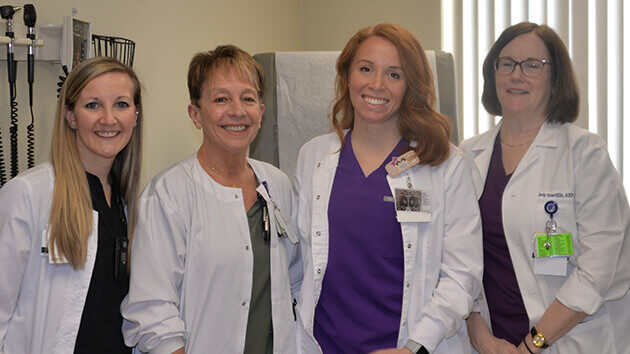Creativity, compassion, and resilience are key for WOC nurses

April 17-23 marks annual Wound, Ostomy, and Continence Nurse Week, and for Albany Medical Center’s certified wound, ostomy, and continence nurses (CWOCNs), it’s never the same day twice. The team of six CWOCNs see about 3,500 consults a year and care for patients who need anything from gentle care after surgery to ostomy education.
“It is a profession for someone that is comfortable with dealing with intimate personal care issues, is creative, confident, articulate, flexible and enjoys teaching,” said Donna Truland, RN, MSN, CWOCN. “Satisfaction comes from an intimacy and personal fulfillment working with patients and families, seeing them grow and learn from your interactions with them.”
Not only are CWOCNs care providers – they also serve as advocates, emotional support, and educators. Their days could include seeing consults and outpatients at pre-admission testing (PAT) for stoma marking (for patients having life-saving surgery that allows bodily waste to pass through the abdomen into an ostomy bag on the outside of the body), making patient care recommendations, teaching patients and their families how to manage ostomies, or changing negative pressure wound therapy dressings, which help draw out fluids and prevent infection. They also work to raise awareness of and reduce the risk of pressure ulcers, or bed sores, and injuries.
“The role is very independent,” said Jody Scardillo, DNP, RN, ANP-BC, CWOCN. “You need to be persistent and flexible, with a dash of creativity to manage the problems we see.”
Scardillo has been a wound, ostomy, and continence nurse for 28 years. She now serves as the outpatient nurse and enjoys the longer-term relationships with patients the role has given her. Her days entail seeing patients with ostomies, wounds, tubes, and drains and educating patient as well as working with inpatient CWOCNs to coordinate care.
When Scardillo began her journey at Albany Medical Center in 1980, she started as an assistant nurse manager in the trauma unit but was always drawn to patients with complex wound and ostomy needs. When a mentor encouraged her to go for the education and certification required for a CWOCN, Scardillo never looked back.
“I was lucky I found my passion in nursing early on in my career,” she said.
Scardillo completed much of her own educational journey while at Albany Medical Center, including obtaining her bachelor’s and master’s degrees, WOC certification and doctorate in nursing practice. In turn, she helps teach her fellow nurses and colleagues.
In addition to her role as a CWOCN, Scardillo has delivered lectures about her profession and published articles and book chapters. She also hosts WOCTALK, a bi-weekly podcast that discusses issues of interest surrounding wound, ostomy, and continence care.
“I love to teach and mentor newer nurses to realize their full potential and enhance their contributions to Albany Medical Center and health care,” said Scardillo.
While work as a CWOCN is challenging, Scardillo said that it’s a rewarding role, both personally and professionally. “Seeing frightened and unsure patients heal, recover and get their confidence and life back is an amazing experience to witness,” she said.